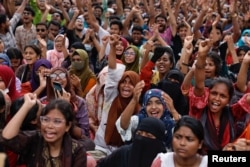Washington —
South Asia’s youth bulge is a ticking time bomb. A demographic dividend looms, but millions of young people lack the job skills to cash in, choking the region’s economic potential.
Almost half of South Asia’s population of 1.9 billion is under 24, the highest number of any region in the world. With nearly 100,000 young people entering the job market daily, the region boasts the largest youth labor force globally.
For years, experts have sounded the alarm: Many of South Asia’s youth lack the education and skills for a modern labor force. A 2019 UNICEF study warned that if nothing changes, more than half risked not finding decent jobs in 2030.
Now, International Youth Day has put the spotlight on the region’s skills-gap crisis. While some South Asian countries have made progress in recent years, UNICEF’s latest figures paint a sobering picture: Ninety-three million children and adolescents in South Asia are out of school; almost 6 in 10 can’t read by age 10; and nearly a third are not in any form of education, employment or training, known as NEET.
“We know that the region has the highest number of children and young people, but sadly at the same time, despite the opportunity that that might bring, we know that for many young people, learning and skilling is not good enough,” Mads Sorensen, UNICEF’s chief adolescent adviser for South Asia, said in an interview with VOA. “This clearly holds them back from reaching their full potential.”
The problem, Sorensen said, comes down to the quality of education: Many teachers cling to old methods, schools in many regions lack basic tools such as computers, and students are not taught the digital skills needed to thrive in the modern workplace.
“So, young people are not really acquiring those skills that we know are very much sought after by the labor market, especially the private sector,” Sorensen said.
The skill deficit extends beyond K-12 education. Higher education enrollment in South Asia has tripled in the past two decades, reaching an average of 27% in 2022, according to the World Bank. Yet the quality of college education remains uneven, with many graduates finding that their hard-earned degrees ill-prepare them for today’s job market.
Big investment but scant returns
Take Ariful Islam, a recent graduate with a business administration degree, who now helps his father in his sweets shop in the Bangladeshi capital, Dhaka. After graduating last year, he had multiple job interviews. But none yielded an offer, forcing him to settle for a position that barely covered his expenses.
Having invested nearly $13,000 on Islam’s education, his father, Akram Khan, said he had to quit his job to start a business. Islam wasn’t earning enough, so Khan needed to boost the family’s income.
“I spent so much money to educate my son, but now he is not getting a job according to his qualifications,” Khan said in an interview with VOA. “As a father, [I] will feel bad.”
Others such as Zahirul Haque, a 2022 graduate in public administration, have been locked out of coveted government jobs.
A controversial quota system favoring Liberation War veterans and their offspring, at the heart of Bangladesh’s recent turmoil, has thwarted his aspirations for public service.
After two years of fruitless government-administered exams, he reluctantly accepted a low-paying job with a local nongovernmental organization.
“It was a little disappointing,” he told VOA.
Bangladesh’s strained job market offers few prospects for young graduates such as Haque. But he said he hasn’t given up hope for a better job.
Good news, sobering news
Bangladesh, once among Asia’s poorest countries, has surged economically in recent decades and is now on track to become a middle-income country by 2026.
Collectively, South Asia is poised to be the fastest-growing emerging market this year, according to the World Bank. In a new report released on Monday, the International Labour Organization, or ILO, said South Asia’s youth unemployment rate fell to a 15-year low of 15.1% last year.
Though signaling an easing job market for young people, the unemployment rate was the highest in the Asia Pacific region, ILO said. What’s more, “too many” young women are excluded from the labor market in South Asia, with the number of women not working or learning at more than 42%, the highest in the region, the ILO said.
Sorensen said that while countries such as Bhutan, the Maldives and Sri Lanka have narrowed the skills gap in recent years, the region’s most populous nations — India, Bangladesh and Pakistan — are lagging behind.
The plight of young women is even more grim. One in four girls in South Asia are married before age 18, their education and careers squandered. Bangladesh’s underage marriage numbers have worsened in recent years, Pakistan’s remains “dire,” Sorensen said.
Pakistan lags most of the region in higher education, with 13% enrollment as of 2022. While the country boasts quality universities, many students complain about outdated curriculums.
The curriculum is “not incorporating the emerging trends of the 21st century,” said Noor Ul Huda, an English major at a public university in Islamabad.
Huda said her major is considered “less practical” than academic fields such as engineering and business, leaving her job prospects bleak.
“The job market is overwhelmingly competitive, and I think I’d have a lot of difficulty finding a job,” she said.
Not ready for jobs
Many parents pouring money into their children’s education confront the same reality: Schools fail to equip students for the job market.
Humna Saleem, a preschool teacher in Rawalpindi, worries about her son, a soon-to-be computer science graduate from a private university. Despite a hefty tuition, he had to learn coding on his own, Saleem said.
“What I observed as an adult is that he is taught a lot of theoretical knowledge, but there are practical skills that are not taught to the students,” she told VOA.
Pakistan’s classrooms, she said, remain stuck in the past, while the world has changed. Students need digital skills and “soft skills,” such as critical thinking and interpersonal communication, not just degrees, she said.
“It doesn’t matter if you are a doctor, or you’re an accountant, or you are an engineer. Whatever profession you choose for yourself, you need to have those skills,” Saleem said.
In recent years, governments in the region have stepped up efforts to close the skills gap.
In India, the Ministry of Skill Development and Entrepreneurship has partnered with UNICEF to provide youth with 21st-century skills, apprenticeships and entrepreneurial opportunities.
In Pakistan, the prime minister’s Youth Skill Development Program, launched in 2013, aims to equip youth with market-driven skills in IT, entrepreneurship, agriculture, tourism and vocational fields.
“We have to equip our youth with the skills in line with modern requirements so that they can contribute to the country’s development,” Pakistan’s education minister, Khalid Maqbool Siddiqui, said in July, according to Associated Press of Pakistan.
In Bangladesh, the National Skills Development Council, led by the prime minister, has introduced a new policy to enhance workforce skills for the modern economy.
Colleges and universities in South Asia have tried to tackle the skills gap crisis by emphasizing critical thinking, creativity, innovation and entrepreneurship. Some have also ramped up digital skills and vocational training to better prepare their graduates for the job market.
Sorensen lauded the regional efforts but said more needs to be done to build a vibrant, modern workforce in South Asia.
“We keep saying that young people are leaders of today, which they are, but they’re also more so leaders of tomorrow,” Sorensen said.
VOA’s Afghan, Bangla and Urdu services contributed to this report.
Source: voanews.com




